
This is our guest house, just five minutes walk from the reception of the Sepilok Orangutan tourist centre and six minutes walk to work at the rehabilitation centre.

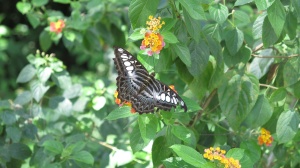
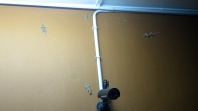

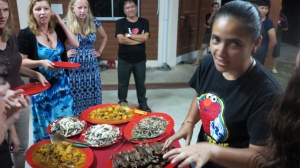
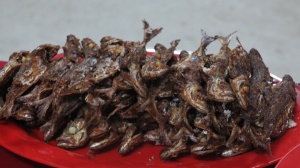

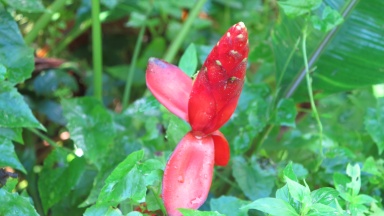
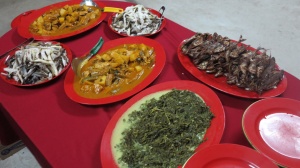

This is our guest house, just five minutes walk from the reception of the Sepilok Orangutan tourist centre and six minutes walk to work at the rehabilitation centre.









First day and t-shirt’s tucked in, drawstring fastened tight, pants tucked into socks, collars up, all buttons fastened, gators on and coated with insect repellent. Leech proofing is an involved process!
We’re off into the jungle; the Sepilok Rehabilitation Centre sits on the edge of the Kabili-Sepilok Forest reserve – 4856 hectares of primary rainforest.
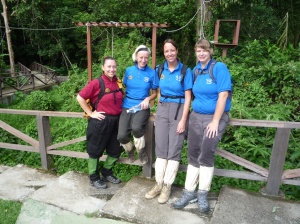
We’re surveying for Orangutan nests. Orangutans make sleeping nests high in the branches of sturdy trees from the age of about 3 years old. Although, at that age the youngsters will just make a small on very close to their mother’s nest. They probably won’t venture further away until 6 or 7 years old.
We need to get at least 300 metres away from the outdoor nursery to ensure any nests we see are not made by the Orangutan’s that have been semi-rehabilitated and occasionally spend the night outside.
We note down the height of the tree, the height of the nest, how old it is (you can estimate by the colour of the dead leaves and how intact the nest is), distance from the trail and what type of tree the nest is in. This data will then be collated on computer to give the centre and overall picture of how many Orangutans are out there and more information on how they’re moving and their habits.
Our guide is one of the rangers, Gabili. He’s very knowledgeable about the flora and fauna and constantly points out different trees and their medicinal uses, animal tracks and identifies the bird calls that echo around us. He learnt a lot of bush lore from his grandfather who used to take him into the bush as a kid.

Although the first couple of days are pretty short – 2 – 2.5 kms, its rough terrain. Climbing over fallen tree trunks (at least the others who’re all tall step over them while do the glamourous sit and swing the leg over) slippery mud, crossing rivers using logs as bridges – very unnerving especially if you think about it too long, 33 degree heat (my t-shirt is wet through in minutes) and lots and lots of leeches!

We’re constantly on the look out for leeches and plucking them off our feet, legs and each other. If you reach out to steady yourself on a branch or tree trunk – you get a leech on your hand or arm. Attempted numerous techniques… pulling (ineffective – they just stretch and stretch and stretch), flicking – works if they haven’t got a good suck on!
Mostly we sprayed them with dettol spray which makes them curl up and tranquillizes them for a few minutes so you can flick them off easily.
LAST DAY TREKKING went on a much longer trek – along a trail that hadn’t been walked for about 2 months. When I say trail… I mean very the path is very clear in some parts but in others, only someone familiar with the area would be able to find their way around.
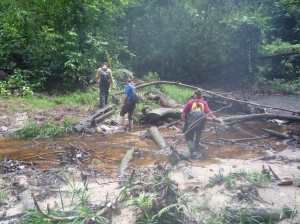
Gabili points out other rangers and trail-walkers marks on the trees and in old logs.
We come across a wide open clearing – after walking for a couple of hours in trees so close only dappled sunlight makes it way through and it’s difficult to make out the trees above 4 metres…entering the clearing is like a hush or momentary pause in the constantly growing, curling, writhing, sucking of the jungle.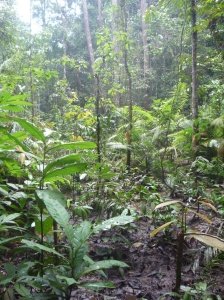
There is marshy ground and sand from a dried river bed. Huge ferns bask in their chance to grow towards the precious sunshine. It felt like a very untouched spot.
Gabili told me the clearing formed when a tree fell and has since rotted away. It must have been massive.
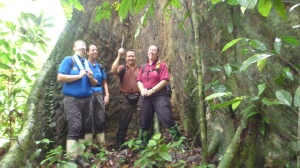
We have seen some pretty big trees and fallen logs though!
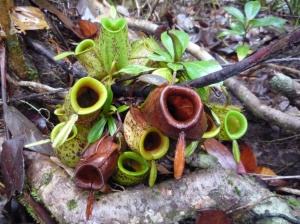
Our destination on this walk was the ‘pitcher plant area’ They only grow in the very middle of the jungle because it’s the only area that’s cool enough.
After 3 hours we got to the water hole. It was really, really hot but the thought of disrobing in the blood-sucking parasite ridden jungle was quite intimidating… but the opportunity to swim in freshwater pool in the middle of the Bornean jungle was just too good to miss.

Clinic week: There are three rotations and my group (2 girls from Netherlands and One English) started our work in the clinic with the youngest Orangutan’s at Sepilok; seven Orangs aged from 1 to 2 -3 years old.
Peanut, Beedo Beedo and Tunduo are the smallest babies aged just over a year old. Beryl, is a wee bit older – she’s my adopted Orangutan. Chiquita is 2, and the boys Gelison and Boogie Boy are just a bit over 2 yrs. They all have very different characters and are all adorable even when they’re being a naughty.It’s been a fantastic week getting to know the babies… and falling just a little bit in love with them.
Every day we start at 8 am – and it’s hot – probably about 36 degrees and extremely humid.
We scrub up, put on gloves and masks to prevent us catching any germs of them and vice versa. Two of us make up the milk, while the other two make up a basket of food.
As soon as the babies hear people around, they start crying. Their cry is a very high-pitched whistling. Almost like a sort of bird call and it can get really loud and piercing when they’re really upset.
The Orang’s smell like wet sheep (but not as strong) crossed with a wet dog. Although that might not sound very nice. The associations I have with it makes it a lovely smell- kind of like cow poo or horse stables.
We take the babies to another outdoor area and then clean their night cages. When you unlock the door to their cage the Orang’s lunge at you in their excitement to get out of their cages, but they always reach for your hand or an arm and latch on. After cleaning the clinic – removing old food and poo, we hose the cages then scrub them all, then hose them again, squeegee the floor then spray entire area with disinfectant. Very sweaty work.
We and the rangers are constantly in and out of kitchen, food storage and enclosure. Everything has locks and grills to stop the released-but-not-keen to-go-too-far Orangutans out. The one occasion you might just slide a grill across and not lock it (- because you’re going back in that room in just a minute) will be the time that Bella will quietly slide the grill across and with her super long arms (adults can have an arm span of around 6 foot) and snake her her hand around the corner and make off with a bottle of Ajax.
Or Michelle or Selamat will sneak into the food store and make off with a bunch of bananas.
It was pouring down with rain, so I wore my poncho to work and carefully hung it up out-of-the-way beside the door.
As I was cleaning the cages I heard a yelling kerfuffle (- this happens pretty regularly, as Orangs get into places they’re not supposed to be… it’s a bit of mad house.) Ibritina, the vet nurse, then told me that Ann had taken off with my poncho – as I looked up and saw her on the roof holding the poncho over her head – I really couldn’t begrudge her.Later the babies dragged it into their cage and beryl pulled a piece with her hands, her feet and her mouth then punched a whole in the middle with her finger. She then put it over head and then pulled her arms through like a little waterproof tutu!
Another time Selamat snuck into the kitchen and seized one of the made up baby bottles. I ran after him and managed to avoid getting bitten as I wrestled it off him with the help of another ranger. SUCCESS! Got it back off him. However, cunningly using the chaos as distraction… little Rosa made her way into the kitchen. I walked in on a very guilty looking ape holding a bottle in each hand and both of her feet, taking rapid swigs out of each in turn. You could see her calculating how long she had before we reached her and she’d have to drop the bottles and bail.
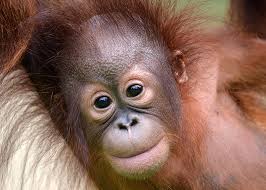
After the cleaning’s done, and if it’s sunny, we start training. We hold the hands of the older Orangutans and walk them down to an area with a lake, a pagoda and some ropes leading to bigger trees.
Chiquita’s a bit lazy and doesn’t like climbing. Found out that she was found when she was very young just three months old and the ranger had to bottle feed her every 2 hours until she was old enough to live at the rehabilitation centre. It explains her affection for people – she loves getting attention instead of climbing into the trees.
Boogie boy is always off and away to the shopping tree (shopping – cos it’s got so much choice!)
When the Orang’s don’t climb and sit on the ground, we have to grab their arms and hand them on the rope or a tree. Then we have to yell ‘Nike Nike’ = climb in Malay.
Chiquita kept climbing down but I suggested we just ignore her because it becomes a game. She sat on an old stump, glancing over to us to see if we were watching her. She then took some of the crumbling wood from the stump and put it on her head… When we didn’t do anything, she brushed it all off. I went down to pick her up for the gazillionth time and couldn’t resist.
She was lying on the ground, so I tickled her under the arm just like a person then when she tried to get my hand away from her underarm, I tickled her tummy and back and forth. She had her mouth open in a big grin… then I stopped and pulled some bit of wood out of her hair. She turned from a mischievous little ape biting and trying not to climb… into a docile little angel. As I was grooming her she looked into my eyes.. The depth of her big brown eyes just made me melt. Oh yes, they’re charming in the extreme.
One day Boogie Boy didn’t even come in for lunch. We left him up the shopping tree. If they’re confident enough to stay out for a couple of hours that’s ok. It is all about getting them back to the trees.
 Week One: and it’s been a slow wait to meet the Orangutans we’ve all travelled so far to see, but one full of first impressions, meeting a dozen or more strangers and some new experiences.
Week One: and it’s been a slow wait to meet the Orangutans we’ve all travelled so far to see, but one full of first impressions, meeting a dozen or more strangers and some new experiences.
ARRIVAL
Arrived in KK and checked into my very flash hotel, and was very quickly down by the pool. Soooo worth the extra bucks to be in one of the very few hotels with a pool.

Met another early arrival, Ruth and we went to the ‘waterfront’ for a drink. At first glimpse (I’ll reassess when I return) KK is not a glamorous town. Depending on the wind direction the wind can carry a foul odour of rotting food from the markets, and the wafting of fish, fresh and cooked. It can also carry delicious scents of the many, many market stalls selling deep-fried everything.
The waterfront is a series of small areas of wooden decks in front (back?) of bars, with a view of an anchored fishing fleet and a few islands.


Checked out of my flash hotel 😦 and made my way on foot to new hotel. Very, very hot but unexpectedly, not humid. Walked into the new hotel to meet a bunch of women sitting around a couple of tables in the dark lounge bar of the lobby. Suddenly it’s like the first day of anything anywhere and intimidating as all hell. But I put on my grown up brave face, met my roomie for the first night, and we were all off for a quick look around the neighbourhood before dinner.

FIRST OPTIONAL ACTIVITY
Up early (4:45 for a 5:30 pick up) to go White Water Rafting! 1 hour and a half in mini bus until we got to train station. One small waiting room with a cafe full of plastic covered tables serving noodles for breakfast and super-duper strong coffee. Grounds sieved, boiling water poured over them, then served with sweetened condensed milk! Teeth grindingly strong and sweet, it was certainly enough to wake up and launch into the day. The train was an old steam train. Sliding windows, hard vinyl covered bench seats.
We made our chuff-chuffing way deep into the mountainous regions that used to be inhabited by tribes known for head hunting.
Meg, Lorraine and I along with 2 french guys got the head guide. Always a good thing to make friends with the coolest dude there. We got the smallest boat, smallest crew and biggest ride. We practiced falling out and getting back in the boat, before heading toward the first rapids. All pretty mellow at first, lots of fun.. high fives made with paddles up in the air. Made it through the HeadHunter, then the Scooby Doo, and everything was going well until The Cobra. Moose our guide warned us it was a twisty, gnarly rapid but he had all confidence in our team making it through.
We did well plunging into the first deep hole with waves smashing over the boat from all sides. I was still trying to paddle while looking up at wet wall. The girl in front of me fell of her sleep and was flat on her back in the boat while we got sucked into the second twist. We didn’t make it quite so well out of that one.
I was off and into the water gulping and seeing nothing but a wall of yellow. My too big helmet slipped over my eyes and as I furiously tried to dog paddle to the surface I had a moment of panic but then found air. Looking around I say Meg and Lorraine had also gone into the river … as well as the 2 french guys. Fortunately head guide and his two mates managed to stop the boat from capsizing. They hauled us back into the boat by our weak arms and the back of our life vests. I’ve had moments I handled with more finesse…
Got our breath back and we were off again. The Cobra was the biggest rapid we faced, I think the guide said it was a grade 4. We made it through the rest of the ride without mishap and jumped overboard to enjoy a float downstream. This was before another guide showed me a picture of a crocodile basking on a rock in the river! ‘But it’s safe,’ he told me ‘they only hang out in the still water, not the rapids.’ Oh well, that’s ok then, I thought.


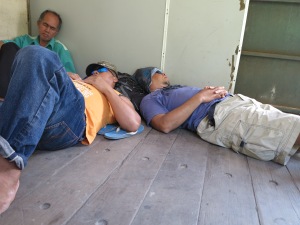

FIRST SIGHTINGS
Next day we flew to Sandarkan, an hour away from KK by plane. Arrived at 3:30 knowing that the Orang Utan feeding time on the platforms (with a boardwalk for the public to view from) was at 4… and Sepilok was 40 mins away from the airport. We were hoping to see the Orang Utans but kind of resigned ourselves to not making it in time. We arrived at Sepilok, leaving our bags in the car walked (very briskly) to the visitors centre. Squirting on the obligatory hand sanitiser at the rainforest boradwalk beginning, we raced into the forest. Any noise was instantly muffled by the tall stands of trees… fat leaves and twisting vines. Cicadas chirped frogs ribbited and numerous other mysterious creatures chittered and ribbeted and hooted. Our excited chatting hushed as we approached a crowd huddled and focused out into the forest, leaning on wooden guard rails, cameras in hand.

We’d arrived in time and there were Orang Utans. Could have watched all day… I may have melted into a puddle of perspiration but it would have been worth it.
SANDAKAN
The rain came down. It’s Monsoon season in Borneo. Didn’t matter too much, today was a sightseeing day. Our organisers told us that the reason we took such a long time to get in touch with the OrangUtans was that 7 days is generally the incubation period for most germs picked up on the way over. Sharing around 96 percent of the same genetic make up means the O’tangs are extremely susceptible to human germs, and vice versa.
So.. we spent some time at the Sandarkan War Memorial Park, a memorial adjacent to the site of a Japanese POW camp during WWII. The visitors centre has photos and information about the 2400 (approx) Australian and British soldiers interned there between January and August 1945. Only six men made it out alive, and all of them were excapees. The prisoners were forced to endure horrific conditions and treatment, including notorious Japanese death marches.

Then it was off to a beautiful Buddhist temple with a sweeping vista looking over the bay and oil tankers.
Driving through Sandakan is frankly depressing. The central city looks like a grey slum with crumbling concrete high rise buildings. Limply hanging clothes festoon the exteriors adding to the general slumpy depression. I’m sure there are some exciting and possibly attractive areas in Sandakan but definitely a gateway town to Sepilok and the Orangutan Centre.
We did get to see an awesome water village. Originally the home of fishermen, and the poor who couldn’t afford land, they’ve now become an option for those who don’t want to pay taxes. Although held up by poles, I’m not sure who puts them in or what happens when people want to build more rooms. It sort of looks like they just tack it on to another room with wood and nails and wishful thinking.
TRAINING DAY 1
First day in uniform! Official T-shirts and long trousers. Very excited and all geared up to begin training. We arrived at the centre and watched a film about the creation of the rehabilitation centre and the successful release back into the wild of a mature male. Off to watch feeding, this time the morning feeding at ten am. Next was a break. Then we went for a lecture about rules of centre. Another break. Then Lunch. The day began to slow quite substantially.
After lunch we finally got to see Orangs behind the scenes.
 Met NooNong who has had cerebral malaria and has been paralysed down one side as a result. Unfortunately she won’t ever be able to be free in the jungle as she’s not strong enough to defend herself or carry her own weight in the trees and she also suffers from seizures. Hopefully her life is enriched with visits by loving volunteers like us.
Met NooNong who has had cerebral malaria and has been paralysed down one side as a result. Unfortunately she won’t ever be able to be free in the jungle as she’s not strong enough to defend herself or carry her own weight in the trees and she also suffers from seizures. Hopefully her life is enriched with visits by loving volunteers like us.
Saw some of the little babies inside the nursery.
As we were leaving saw semi-wild Orang Utans free and wandering.
They are free to leave but for whatever reason… affection.. free food.. attention.. they prefer to hang around.
There are some unfortunate but amusing effects from this.
A car with a packet of instant noodles had the windscreen smashed to get to them.
A pregnant female, Ann, takes a dislike to women every time she gets up the duff. She waits outside the clinic for the Vet Dr Laura to leave. Everyday at 3pm she waits to chase Dr Laura to her car.
One of the centre staff bought herself afternoon tea from the cafeteria but only made it half way back to her office before one of the semi-wild Orangs must’ve smelt the food and mugged her. Climbing up her leg and rummaging in her backpack until they got her snack.
It’s definitely very much part of the life here at the centre and no-one seems to mind too much. Part of the privilege of being in such close contact with these incredible creatures.
TRAINING DAY 2: FIRST CONTACT
Today we got up and close with our charges in the clinic. I carried little Peanut out to the outdoor play area. He is an adorable baby. Huge eyes with the longest eyelashes and a piebald pot-belly. I reached into his cage and he wrapped his arms and legs around my arm. Amazing but all over far too quickly.
After lunch, we visited another part of the centre which is due to be open to the public next year. In this area they’re rehabilitating sun bears. The smallest of the bear family.
They’d just finished their visitors centre – empty shell but all complete… when someone forgot to lock-up properly. When the Sun Bear workers arrived the next morning their office was trashed. The Orangs had gotten in and pulled the place apart. The fridge hung open, empty.
As we went up to see the Sunbears we were standing on a high platform above their enclosures. We spotted several of the aboreal bears (so cool to see one climbing up a high tree – just clinging to the side of the trunk) , and some macaques were also around.
I took a photo of one when suddenly someone said ‘err… they’re all coming’ We were surrounded by a troupe (at least 3) of pig tailed macaques – much more vicious than the long tailed apparently. We all bunched together then Gloria who was the education officer hurried us down the board walk. The next minute someone yelled ‘RUN’ 13 woman thundering down the boardwalk squealing.. I was laughing so much it was hard to run until I turned and saw the white’s of Gloria’s freaking out eyes as she ran past me and the sight of the ahem testicles of the alpha male. It was then not so funny. We ran down a switch-backing boardwalk, one girl lost her jandal but noone was pausing to pick it up… every time we turned a corner I glanced backwards expecting the Evil Monkey King to have abandoned his pursuit but the bugger remained right on our tails. Gloria was yelling for staff as we ended up back at the HQ. A couple of guys were quick to seize big sticks and ran off to frighten the EMK away. Running in 36 degree heat in the extreme humidity of the jungle leads to extreme sweat. Not recommended. Unless you’re being chased by an Evil Monkey King of course.
Part of my fee includes the adoption of an Orangutan for a year.. This is baby Beryl!
One of the things I’m most looking forward to is meeting this little ‘Ranga.
The following is taken from the Orangutan Appeal Newsletter – check out the page to see how to help and how to adopt your own ‘Ranga! www.orangutan-appeal.org.uk
BERYL’S STORY
Date arrived at Sepilok Rehabilitation Centre: 4th May 2012
Age on arrival: 1 year old
Sex: Female
Weight 3.5kg
On 28th April 2012 on a plantation over a hundred kilometres away from the Sepilok Orangutan Rehabilitation Centre, a baby orangutan sat in the undergrowth crying for her mother. The nearby workers heard her calling and went to investigate and found the baby girl all alone and very scared. Her mother was nowhere to be seen. The workers knew something terrible must have happened as a mother would never leave her baby unprotected and vulnerable to any predators in the area.
The workers decided to leave her for a while to see if her mother returned but sadly she never did. They knew that if they were to save this baby they needed to get help and so they decided to take the baby to the plantation manager. The manager knew that it is illegal to keep orangutans as pets and he also knew about Sepilok who rescue orphaned and injured orangutans and immediately made a phone call to ask for their help. Soon the rangers from Sepilok were on their way but as it would take several hours the workers fed the baby milk and comforted her whilst they waited.
Senior ranger Elis arrived the next morning and collected the baby from the plantation manager and prepared the youngster for the long journey back to the centre. On arrival the baby was very frightened and did not like being put down as she obviously missed the contact which all young orangutans have with their mother. It was decided to name the baby “Beryl” after a loyal supporter.
After she had been examined by the vet, who took some blood tests and her temperature, she was found to be well and did not appear to have suffered too much from her terrible ordeal. Nurse Ibris wrapped her in a soft warm towel and tucked Beryl up in a hammock in the quarantine ward where she would live for the next three months and receive a lot of TLC. It’s very important that all new arrivals spend time in quarantine to ensure they are not carrying any contagious diseases.
After her quarantine period was over, Beryl was introduced to the other youngsters in the nursery such as Chikita and Gelison and was allowed to join them in the outdoor enclosure. Beryl loves her new environment as she can climb and play with the others for hours at a time. Her favourite place is her hammock where she often takes her food to hide it from the others.
Although Beryl is very tiny she is a very strong and feisty little orangutan and is already developing a mischievous side to her personality. Beryl is learning quickly from her companions the things that normally her mother would have taught her in the wild. Beryl has stolen the hearts of all her carers as she is absolutely adorable and there is no doubt her journey through the rehabilitation process will be an exciting and interesting one.